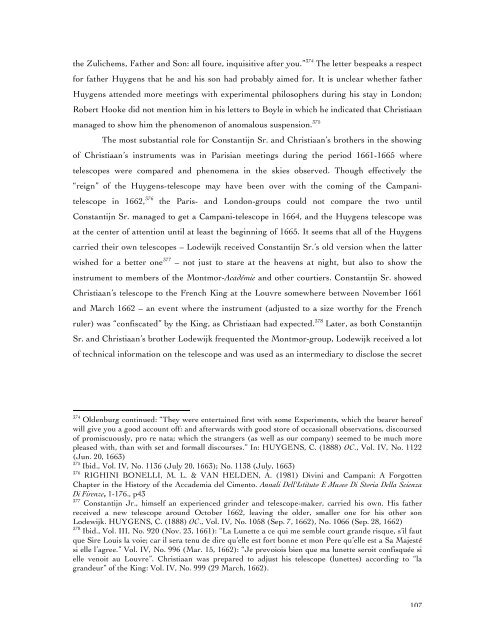Christiaan Huygens – A family affair - Proeven van Vroeger
Christiaan Huygens – A family affair - Proeven van Vroeger
Christiaan Huygens – A family affair - Proeven van Vroeger
You also want an ePaper? Increase the reach of your titles
YUMPU automatically turns print PDFs into web optimized ePapers that Google loves.
the Zulichems, Father and Son: all foure, inquisitive after you.” 374 The letter bespeaks a respect<br />
for father <strong>Huygens</strong> that he and his son had probably aimed for. It is unclear whether father<br />
<strong>Huygens</strong> attended more meetings with experimental philosophers during his stay in London;<br />
Robert Hooke did not mention him in his letters to Boyle in which he indicated that <strong>Christiaan</strong><br />
managed to show him the phenomenon of anomalous suspension. 375<br />
The most substantial role for Constantijn Sr. and <strong>Christiaan</strong>’s brothers in the showing<br />
of <strong>Christiaan</strong>’s instruments was in Parisian meetings during the period 1661-1665 where<br />
telescopes were compared and phenomena in the skies observed. Though effectively the<br />
“reign” of the <strong>Huygens</strong>-telescope may have been over with the coming of the Campani-<br />
telescope in 1662, 376 the Paris- and London-groups could not compare the two until<br />
Constantijn Sr. managed to get a Campani-telescope in 1664, and the <strong>Huygens</strong> telescope was<br />
at the center of attention until at least the beginning of 1665. It seems that all of the <strong>Huygens</strong><br />
carried their own telescopes <strong>–</strong> Lodewijk received Constantijn Sr.’s old version when the latter<br />
wished for a better one 377 <strong>–</strong> not just to stare at the heavens at night, but also to show the<br />
instrument to members of the Montmor-Académie and other courtiers. Constantijn Sr. showed<br />
<strong>Christiaan</strong>’s telescope to the French King at the Louvre somewhere between November 1661<br />
and March 1662 <strong>–</strong> an event where the instrument (adjusted to a size worthy for the French<br />
ruler) was “confiscated” by the King, as <strong>Christiaan</strong> had expected. 378 Later, as both Constantijn<br />
Sr. and <strong>Christiaan</strong>’s brother Lodewijk frequented the Montmor-group, Lodewijk received a lot<br />
of technical information on the telescope and was used as an intermediary to disclose the secret<br />
374 Oldenburg continued: “They were entertained first with some Experiments, which the bearer hereof<br />
will give you a good account off: and afterwards with good store of occasionall observations, discoursed<br />
of promiscuously, pro re nata; which the strangers (as well as our company) seemed to be much more<br />
pleased with, than with set and formall discourses.” In: HUYGENS, C. (1888) OC., Vol. IV, No. 1122<br />
(Jun. 20, 1663)<br />
375 Ibid., Vol. IV, No. 1136 (July 20, 1663); No. 1138 (July, 1663)<br />
376 RIGHINI BONELLI, M. L. & VAN HELDEN, A. (1981) Divini and Campani: A Forgotten<br />
Chapter in the History of the Accademia del Cimento. Annali Dell'Istituto E Museo Di Storia Della Scienza<br />
Di Firenze, 1-176., p43<br />
377 Constantijn Jr., himself an experienced grinder and telescope-maker, carried his own. His father<br />
received a new telescope around October 1662, leaving the older, smaller one for his other son<br />
Lodewijk. HUYGENS, C. (1888) OC., Vol. IV, No. 1058 (Sep. 7, 1662), No. 1066 (Sep. 28, 1662)<br />
378 Ibid., Vol. III, No. 920 (Nov. 23, 1661): “La Lunette a ce qui me semble court grande risque, s’il faut<br />
que Sire Louis la voie; car il sera tenu de dire qu’elle est fort bonne et mon Pere qu’elle est a Sa Majesté<br />
si elle l’agree.” Vol. IV, No. 996 (Mar. 15, 1662): “Je prevoiois bien que ma lunette seroit confisquée si<br />
elle venoit au Louvre”. <strong>Christiaan</strong> was prepared to adjust his telescope (lunettes) according to “la<br />
grandeur” of the King: Vol. IV, No. 999 (29 March, 1662).<br />
107


